An interview with Dr. Priestly Shan | Vice-Chancellor | Alliance University
In an exclusive interview with The People Management magazine, Dr. Priestly Shan shares insights on University’s Corporate Mentorship Program, Social Internship series, industry internships, Industry-sponsored makerspaces and other co-created active-learning labs to ensure students move from campus to company ready to create immediate value.
Q1. What are the core Strengths of the Alliance University?
Alliance University has rapidly emerged as a benchmark for private higher education in India: it earned an NAAC A+ grade on its very first accreditation visit in 2024, holds #18 in Law and #71 in Management in the NIRF 2024, and features #2 among 36 private universities (and #10 overall) in the Times B-School Survey 2025, which also lists the institution #5 nationally for placements. Its drive for responsible growth is highlighted by a #1 ranking in the National Sustainability Impact Institutions Ranking 2024, underscoring deep commitments to ESG and community engagement. Internationally, AU appears in the 751–800 band of the QS Asia University Rankings 2024 and draws strength from a 33000+ global alumni network. Fourteen constituent schools, powered by 650-plus faculty, deliver interdisciplinary pathways on a 60-acre smart campus that houses Bloomberg-enabled trading floors, 14 Centres of Excellences in Computer vision, Material Science, Propulsion systems, Public Policy, Robotics etc, specialised laboratories in ARVR, IoS development, Additive Manufacturing, Maker Space etc and an expanding digital library; in January 2025 the research ecosystem was recognised by the Government of India as a Scientific & Industrial Research Organisation (SIRO). The university’s industry alignment is reflected in the steady presence of global recruiters-among them PWC, EY, KPMG, Toyota etc -who return each year to tap its talent, affirming Alliance University’s synthesis of quality assurance, innovation and social impact.
2. What opportunities do you see for Alliance University to play on the national or international stage?
Alliance University can amplify its impact by forging dual-degree and split-site research programmes with top-tier foreign institutions under the new transnational-education rules; positioning its campus as a go-to “Study in India” destination for students from across the globe through scholarships and multilingual support; leveraging its SIRO status to anchor government-funded mission hubs in renewable materials, additive manufacturing and AI-driven healthcare. Leveraging on NAAC A+, scaling UGC-compliant online master’s and stackable micro-credentials for working professionals across the Global South, solidifying its sustainability credentials by publishing transparent SDG metrics and competing for top slots in global impact rankings; and contributing faculty expertise to G20 and other multilateral forums to shape policy on tech-enabled learning and future-of-work skills-moves that together can shift the university from respected private player to nationally indispensable and internationally networked institution.
3. What activities and programs are offered by the University to ensure students are ready for the Industry?
Alliance University primes graduates for the workplace through a multi-layered ecosystem: its flagship Corporate Mentorship Program pairs students with senior executives who coach them on role-fit and professional habits. The structured Social Internship series channels undergraduates into community projects that hone empathy and project-management skills while delivering real social value; regular Alumni Mentoring Sessions run by the Alliance Alumni Association bridge classroom learning with current market realities. Office of Career Advancement mandates industry internships for every cohort and brokers placement-linked training. Stackable industry certifications from partners such as Coursera, ABB, Google, IBM, EC-Council, AWS, ACCA, CMA, Siemens etc are embedded in the curriculum so graduates leave with portable credentials on day one. Industry-sponsored makerspaces and other co-created active-learning labs let learners prototype, test and fail fast on real equipment. Also, seasoned practitioners sit on
curriculum boards to co-curate course delivery, keeping syllabi in lock-step with sector needs. Together, these layers ensure Alliance students move from campus to company ready to create immediate value.
4. Collaboration with industry is crucial. Could you explain how Alliance University forms partnerships with multinational corporations, and can you share examples of collaborations that have benefitted both the university and industry partners?
Alliance University follows a “co-create, co-deliver, co-hire” model in courting multinational partners: its Industry Interface Cell first maps employer skill-gaps through a corporate advisory board, then drafts memoranda that embed company specialists in curriculum committees, establish joint infrastructure, reserve internships and capstone projects for talent scouting, and schedule quarterly steering reviews that keep learning outcomes aligned with market needs. This framework has yielded an IBM Skills Academy that supplies cloud-and-AI courseware while giving IBM a ready pool of certified graduates; an Infosys Springboard partnership that grants students access to thousands of nano-courses and lets Infosys pre-screen interns; a Centre of Excellence in Computer Vision with Proglint where faculty and engineers share GPU clusters and co-develop commercial prototypes; an AWS Cloud Bootcamp that puts undergraduates on AWS certification tracks and feeds Amazon’s Bengaluru talent funnel; a 190-company Corporate Mentorship Network through which executives mentor student teams on live business challenges, gaining early access to high performers; and an Apple iOS App-Development Lab that equips a dedicated studio for elective courses while strengthening Apple’s regional developer pipeline. Together these collaborations integrate industry expertise into teaching and research, provide students with hands-on experience and portable credentials, and offer corporate partners a de-risked hiring stream and innovation inputs-a clear win-win for both sides.
5. If you had the authority to modify one policy in the education sector, what would it be? Can you share your thoughts on what specific area you would like to see improvements in?
If I could rewrite just one education-sector policy, I would overhaul India’s ranking and accreditation regime- NIRF, NAAC, NBA and the rest-in such a way that institutional standing depends first and foremost on demonstrable student outcomes and quality research. Rankings would be re-weighted so that at least half of every score stems from this verified data plus authenticated employer feedback, alumni trajectories and student-well-being indices, while accreditation would become a two-step process (as specified in the NAAC Reforms): a basic pass-fail licence to operate and a performance tier earned through transparent outcome evidence, not paperwork. Firewalls between rankers and their consulting arms, open machine-readable data feeds, real-time student and employer reviews, and an independent data-forensics unit with whistle-blower protection would further curb conflicts of interest and manipulation. By embedding these protections and metrics, the system would refocus universities on learning gain, career success and stakeholder satisfaction-transforming quality assurance from a reputation game into a reliable signal of genuine educational value.



